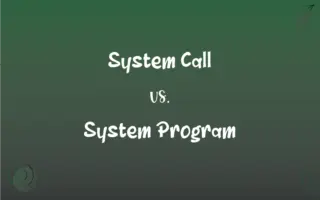Conscious Proprioception vs. Unconscious Proprioception: What's the Difference?
Edited by Aimie Carlson || By Harlon Moss || Published on February 1, 2024
Conscious proprioception refers to awareness of body position and movement in space. Unconscious proprioception refers to automatic, subconscious sensing of body position and movement.

Key Differences
Conscious proprioception refers to the deliberate awareness of the position and movement of one's body parts. Conversely, unconscious proprioception operates subconsciously, controlling movements without active thought.
Activities like dancing or sports require conscious proprioception for coordinated movement. In contrast, unconscious proprioception maintains balance and posture without conscious effort.
Conscious proprioception involves the cerebral cortex, enabling intentional adjustment of movements. Unconscious proprioception, however, relies on reflex pathways and the spinal cord for automatic responses.
Rehabilitation after an injury often focuses on enhancing conscious proprioception for better control. Meanwhile, unconscious proprioception naturally manages everyday activities like walking without focused attention.
Conscious proprioception can be improved through practice and training. Unconscious proprioception, while not as directly trainable, adapts through repetition and habituation.
ADVERTISEMENT
Comparison Chart
Awareness Level
Active and deliberate awareness
Automatic and subconscious
Involvement in Activities
Necessary for coordinated, precise movements
Maintains basic posture and balance
Brain Involvement
Cerebral cortex for decision making
Reflex pathways and spinal cord for automatic responses
Improvement Method
Can be enhanced through practice and rehabilitation
Adapts automatically through habit and repetition
Role in Daily Life
Important for complex or new tasks
Integral to routine, everyday movements
ADVERTISEMENT
Conscious Proprioception and Unconscious Proprioception Definitions
Conscious Proprioception
This type of proprioception is key in learning and perfecting skills.
Conscious proprioception is crucial for a dancer to master new steps.
Unconscious Proprioception
It controls balance and posture without active thought.
Unconscious proprioception keeps us upright when standing in a moving bus.
Conscious Proprioception
Conscious proprioception is the awareness of limb position for precise movements.
While learning to play the piano, conscious proprioception helps in finger placement.
Unconscious Proprioception
Unconscious proprioception is the body's automatic sensing of position and movement.
Walking on uneven ground is managed by unconscious proprioception.
Conscious Proprioception
Conscious proprioception requires mental focus and attention.
Learning to drive involves conscious proprioception for coordinating pedals and steering.
Unconscious Proprioception
Unconscious proprioception functions through reflexes and spinal cord pathways.
Adjusting foot position on a slippery surface is done by unconscious proprioception.
Conscious Proprioception
It's the intentional control over body movements in space.
Gymnasts use conscious proprioception to execute complex routines.
Unconscious Proprioception
Unconscious proprioception operates in the background, managing basic movements.
Maintaining balance while carrying groceries is a task of unconscious proprioception.
Conscious Proprioception
Conscious proprioception involves actively sensing muscle tension and limb position.
In yoga, conscious proprioception aids in maintaining challenging poses.
Unconscious Proprioception
This proprioception type is integral to everyday, habitual activities.
Unconscious proprioception allows us to climb stairs without looking at each step.
FAQs
Can conscious proprioception be improved?
Yes, through practice and focused training.
How does unconscious proprioception function?
It operates automatically, controlling balance and posture subconsciously.
Is unconscious proprioception always accurate?
Generally, but it can be impaired due to neurological disorders.
What is conscious proprioception?
It's the awareness of body position and movement, requiring active thought.
How important is conscious proprioception in sports?
Extremely important for coordination and precision in movements.
How does aging affect conscious proprioception?
It may decline, making focused training more important.
Can unconscious proprioception be consciously controlled?
Not directly; it's mostly an automatic process.
What brain areas are involved in conscious proprioception?
Primarily the cerebral cortex.
What role does conscious proprioception play in rehabilitation?
It's crucial for retraining and regaining control of movements post-injury.
Are there exercises to enhance unconscious proprioception?
Yes, repetitive and balance-focused activities can help.
Does meditation affect conscious proprioception?
It can enhance awareness of body position and movement.
Does unconscious proprioception require learning?
It's mostly innate but can adapt and improve through repetition.
How does unconscious proprioception help in driving?
It assists in maintaining posture and basic control without active thought.
How is conscious proprioception tested?
Through exercises that require deliberate control of limb positioning.
Is unconscious proprioception the same as instinct?
Not exactly, but it functions instinctively to manage basic movements.
How do athletes train conscious proprioception?
Through drills that focus on precise control and awareness of movement.
Can certain diseases impair unconscious proprioception?
Yes, neurological diseases can disrupt this automatic sensing.
Can proprioceptive training prevent injuries?
Yes, especially in sports, by enhancing body awareness and control.
Can injury affect conscious proprioception?
Yes, injuries can impair proprioceptive awareness, requiring rehabilitation.
Does sleep affect unconscious proprioception?
Unconscious proprioception remains active to a degree during sleep for basic postural control.
About Author
Written by
Harlon MossHarlon is a seasoned quality moderator and accomplished content writer for Difference Wiki. An alumnus of the prestigious University of California, he earned his degree in Computer Science. Leveraging his academic background, Harlon brings a meticulous and informed perspective to his work, ensuring content accuracy and excellence.
Edited by
Aimie CarlsonAimie Carlson, holding a master's degree in English literature, is a fervent English language enthusiast. She lends her writing talents to Difference Wiki, a prominent website that specializes in comparisons, offering readers insightful analyses that both captivate and inform.







































































